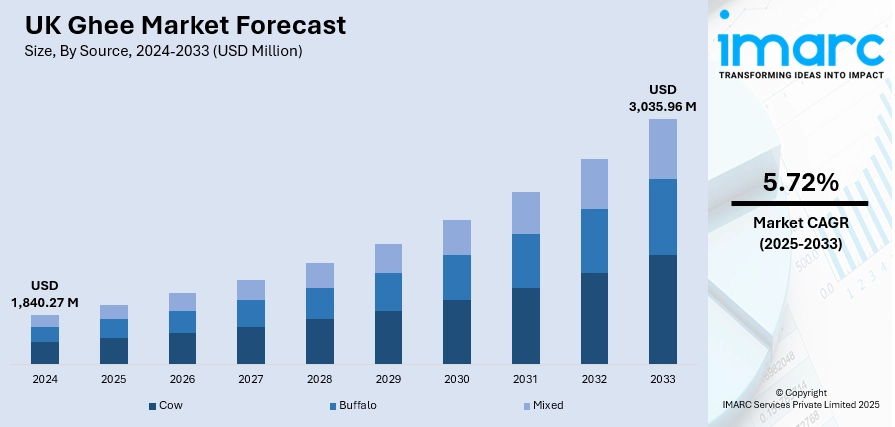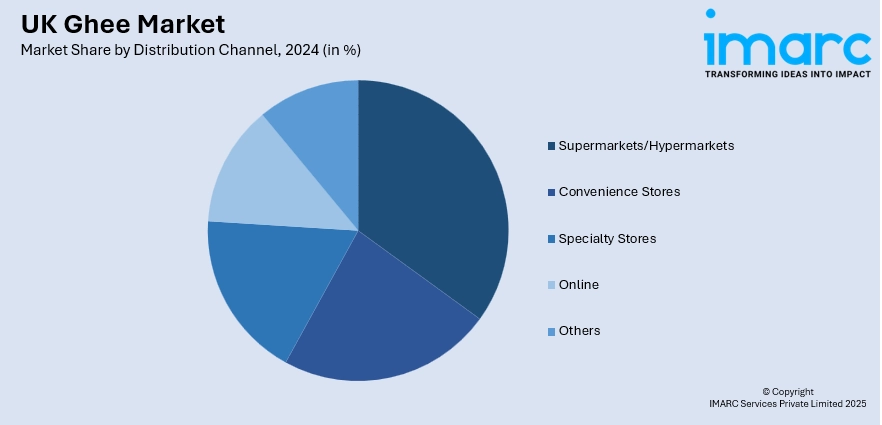
UK Ghee Market Size, Share, Trends and Forecast by Source, Distribution Channel, End User, and Region, 2025-2033
UK Ghee Market Overview:
The UK ghee market size reached USD 1,840.27 Million in 2024. The market is projected to reach USD 3,035.96 Million by 2033, exhibiting a growth rate (CAGR) of 5.72% during 2025-2033. The market is driven by rising health consciousness among UK consumers, who are increasingly opting for traditional and natural fats like ghee due to its perceived health benefits. Apart from this, the expanding South Asian diaspora and growing popularity of ethnic cuisines are fueling demand for authentic ghee-based cooking. Moreover, the proliferation of premium and organic ghee variants through mainstream retail and e-commerce platforms is further augmenting the UK ghee market share.
|
Report Attribute
|
Key Statistics
|
|---|---|
|
Base Year
|
2024
|
|
Forecast Years
|
2025-2033
|
|
Historical Years
|
2019-2024
|
| Market Size in 2024 | USD 1,840.27 Million |
| Market Forecast in 2033 | USD 3,035.96 Million |
| Market Growth Rate 2025-2033 | 5.72% |
UK Ghee Market Trends:
Health-Conscious Consumption and Functional Food Appeal
The growing emphasis on health and wellness among UK consumers has significantly contributed to the rising popularity of ghee. As individuals become more aware of the potential negative health effects of heavily processed oils, there is a clear shift toward natural alternatives. Ghee, known for its rich content of fat-soluble vitamins and high smoke point, is gaining acceptance as a healthier fat source suitable for both cooking and nutritional supplementation. Its association with gut health, immune support, and anti-inflammatory properties further reinforces its appeal among consumers adopting holistic or functional diets. Additionally, the influence of Ayurvedic principles, where ghee is regarded as a medicinal fat, has permeated mainstream wellness culture in the UK, especially among those seeking plant-based or natural lifestyles. An industry report highlights that a comprehensive review of Ayurvedic literature examined references to milk and dairy products across eleven key texts spanning more than 3,000 years. The analysis identified approximately 4,000 mentions of milk-derived items, with ghee being referenced 774 times—making it the most frequently cited dairy product. Also, this trend is particularly evident among younger demographics and fitness-focused individuals, who often integrate ghee into dietary routines such as bulletproof coffee or low-carbohydrate meal plans. The product’s versatility and perceived purity support its positioning as both a culinary staple and a health-enhancing ingredient.

To get more information on this market, Request Sample
Expansion through E-commerce and Diaspora Influence
E-commerce growth has become a significant factor propelling the UK ghee market growth, allowing brands—both established and emerging—to connect with a wider audience beyond traditional ethnic markets. With the increased internet penetration, digital ordering is considered convenient for consumers to access niche food products such as ghee from home. Industry reports indicate that, as of early 2024, there were around 66.33 million internet users in the United Kingdom, representing a usage rate of 97.8% across the population. Apart from this, online platforms also facilitate greater product discovery, enabling buyers to explore various brands, sizes, and formulations that may not be available in physical stores. Concurrently, the expanding South Asian diaspora in the UK continues to exert a strong influence on ghee consumption patterns. Ghee remains a staple in traditional cooking within these communities, and the increasing intermingling of cultures has introduced the product to a broader population. Moreover, recipe sharing on social media, food blogs, and influencer endorsements has normalized ghee’s presence in British kitchens. This digital and demographic expansion is driving market penetration, allowing ghee to evolve from a culturally specific product into a mainstream culinary and wellness item.
UK Ghee Market Segmentation:
IMARC Group provides an analysis of the key trends in each segment of the market, along with forecasts at the country and regional levels for 2025-2033. Our report has categorized the market based on source, distribution channel, and end user.
Source Insights:
- Cow
- Buffalo
- Mixed
The report has provided a detailed breakup and analysis of the market based on the source.This includes cow, buffalo, and mixed.
Distribution Channel Insights:

- Supermarkets/Hypermarkets
- Convenience Stores
- Specialty Stores
- Online
- Others
A detailed breakup and analysis of the market based on the distribution channel have also been provided in the report. This includes supermarkets/hypermarkets, convenience stores, specialty stores, online, and others.
End User Insights:
- Retail
- Institutional
The report has provided a detailed breakup and analysis of the market based on the end user. This includes retail and institutional.
Regional Insights:
- London
- South East
- North West
- East of England
- South West
- Scotland
- West Midlands
- Yorkshire and The Humber
- East Midlands
- Others
The report has also provided a comprehensive analysis of all the major regional markets, which include London, South East, North West, East of England, South West, Scotland, West Midlands, Yorkshire and The Humber, East Midlands, and others.
Competitive Landscape:
The market research report has also provided a comprehensive analysis of the competitive landscape. Competitive analysis such as market structure, key player positioning, top winning strategies, competitive dashboard, and company evaluation quadrant has been covered in the report. Also, detailed profiles of all major companies have been provided.
UK Ghee Market Report Coverage:
| Report Features | Details |
|---|---|
| Base Year of the Analysis | 2024 |
| Historical Period | 2019-2024 |
| Forecast Period | 2025-2033 |
| Units | Million USD |
| Scope of the Report |
Exploration of Historical Trends and Market Outlook, Industry Catalysts and Challenges, Segment-Wise Historical and Future Market Assessment:
|
| Sources Covered | Cow, Buffalo, Mixed |
| Distribution Channels Covered | Supermarkets/Hypermarkets, Convenience Stores, Specialty Stores, Online, Others |
| End Users Covered | Retail, Institutional |
| Regions Covered | London, South East, North West, East of England, South West, Scotland, West Midlands, Yorkshire and The Humber, East Midlands, Others |
| Customization Scope | 10% Free Customization |
| Post-Sale Analyst Support | 10-12 Weeks |
| Delivery Format | PDF and Excel through Email (We can also provide the editable version of the report in PPT/Word format on special request) |
Key Questions Answered in This Report:
- How has the UK ghee market performed so far and how will it perform in the coming years?
- What is the breakup of the UK ghee market on the basis of source?
- What is the breakup of the UK ghee market on the basis of distribution channel?
- What is the breakup of the UK ghee market on the basis of end user?
- What is the breakup of the UK ghee market on the basis of region?
- What are the various stages in the value chain of the UK ghee market?
- What are the key driving factors and challenges in the UK ghee market?
- What is the structure of the UK ghee market and who are the key players?
- What is the degree of competition in the UK ghee market?
Key Benefits for Stakeholders:
- IMARC’s industry report offers a comprehensive quantitative analysis of various market segments, historical and current market trends, market forecasts, and dynamics of the UK ghee market from 2019-2033.
- The research report provides the latest information on the market drivers, challenges, and opportunities in the UK ghee market.
- Porter's five forces analysis assist stakeholders in assessing the impact of new entrants, competitive rivalry, supplier power, buyer power, and the threat of substitution. It helps stakeholders to analyze the level of competition within the UK ghee industry and its attractiveness.
- Competitive landscape allows stakeholders to understand their competitive environment and provides an insight into the current positions of key players in the market.
Need more help?
- Speak to our experienced analysts for insights on the current market scenarios.
- Include additional segments and countries to customize the report as per your requirement.
- Gain an unparalleled competitive advantage in your domain by understanding how to utilize the report and positively impacting your operations and revenue.
- For further assistance, please connect with our analysts.
 Request Customization
Request Customization
 Speak to an Analyst
Speak to an Analyst
 Request Brochure
Request Brochure
 Inquire Before Buying
Inquire Before Buying




.webp)




.webp)












